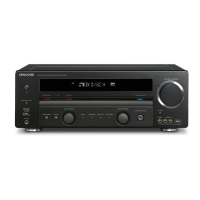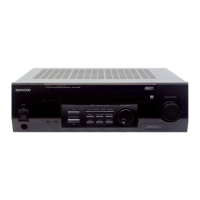Do you have a question about the Kenwood KRF-V50030D and is the answer not in the manual?
Selects the AC voltage for unit operation based on region.
Essential warnings to prevent electric shock and fire hazards.
Instructions for unpacking, checking accessories, and initial setup.
Guidance on resetting the microcomputer for operational issues.
Equipment may generate RF energy; modifications require approval.
Guidelines for proper grounding of CATV systems.
Information on the product's energy efficiency compliance.
Instructions for cleaning and advice against contact cleaner use.
Explains the manual's structure and how to find information.
Highlights advanced capabilities like Dolby Pro Logic and DTS.
Identifies and explains the function of buttons, knobs, and indicators on the receiver.
Details the various input/output jacks and terminals on the receiver's back panel.
Guides on connecting various audio sources to the receiver.
Instructions for connecting video devices like VCRs and DVD players.
Specifics for connecting a 6-channel DVD player for surround sound.
How to connect digital audio sources like CD players and LD players.
Configuring digital/analog input selection for various sources.
Connecting video components like camcorders or game consoles.
Guide for connecting AM and FM antennas for radio reception.
Linking components for convenient system control operations.
Steps for connecting front, center, and surround speakers correctly.
Recommendations for optimal placement of surround sound speakers.
Adjusting radio channel spacing for different regions.
Instructions for loading batteries and using the remote control.
Configuring receiver settings for connected speakers (subwoofer, center, surround).
Adjusting input levels for analog sources to prevent distortion.
Choosing between digital and analog audio inputs for specific sources.
Activating speaker systems A, B, or both for playback.
Steps to power on the receiver and related components.
Selecting and playing audio/video sources.
Fine-tuning bass, treble, and other sound characteristics.
Enabling one-touch low frequency emphasis for enhanced bass.
Temporarily silencing the audio output from speakers.
Bypassing audio processing for direct signal to amplifier.
How to use headphones for private listening.
Steps for recording audio from analog sources onto tape or MD.
Steps to record video from a selected source to a deck.
How to record digital audio signals using A-REC or M-REC modes.
How to manually or automatically tune into radio stations.
Storing favorite stations for quick recall.
Accessing stored radio stations using numeric keys.
Sequential playback of stored radio stations using P.CALL function.
Introduction to various surround sound listening modes available.
Enjoying 5.1 channel digital surround sound from AC-3 sources.
Reproducing theater-like surround sound from Dolby Surround sources.
Providing surround effect without dedicated surround speakers.
Playing back DTS, Dolby Digital, Pro Logic, and 3 Stereo sources.
Experiencing multi-channel audio from DVD players.
Making further sound adjustments like bass, treble, and levels.
Compressing dynamic range for low-volume listening.
Playing back high-resolution 96kHz LPCM audio sources.
Procedure to reset the unit's microcomputer for malfunctions.
Common amplifier problems and their solutions.
Common radio tuner problems and their solutions.
Technical specifications for the audio output of VR-407/406 models.
Specifications for digital audio inputs and outputs.
Technical details for video input and output connections.
Specifications related to FM radio reception.
Specifications related to AM radio reception.
Power consumption, dimensions, and weight of the unit.
Corrected procedures for operating components with the remote control.
Guidelines for safe power source connection and cord handling.
Safety advice on plug polarization, cabinet ventilation, and heat sources.
Precautions regarding object entry, magnetic fields, and cleaning.
Selects the AC voltage for unit operation based on region.
Essential warnings to prevent electric shock and fire hazards.
Instructions for unpacking, checking accessories, and initial setup.
Guidance on resetting the microcomputer for operational issues.
Equipment may generate RF energy; modifications require approval.
Guidelines for proper grounding of CATV systems.
Information on the product's energy efficiency compliance.
Instructions for cleaning and advice against contact cleaner use.
Explains the manual's structure and how to find information.
Highlights advanced capabilities like Dolby Pro Logic and DTS.
Identifies and explains the function of buttons, knobs, and indicators on the receiver.
Details the various input/output jacks and terminals on the receiver's back panel.
Guides on connecting various audio sources to the receiver.
Instructions for connecting video devices like VCRs and DVD players.
Specifics for connecting a 6-channel DVD player for surround sound.
How to connect digital audio sources like CD players and LD players.
Configuring digital/analog input selection for various sources.
Connecting video components like camcorders or game consoles.
Guide for connecting AM and FM antennas for radio reception.
Linking components for convenient system control operations.
Steps for connecting front, center, and surround speakers correctly.
Recommendations for optimal placement of surround sound speakers.
Adjusting radio channel spacing for different regions.
Instructions for loading batteries and using the remote control.
Configuring receiver settings for connected speakers (subwoofer, center, surround).
Adjusting input levels for analog sources to prevent distortion.
Choosing between digital and analog audio inputs for specific sources.
Activating speaker systems A, B, or both for playback.
Steps to power on the receiver and related components.
Selecting and playing audio/video sources.
Fine-tuning bass, treble, and other sound characteristics.
Enabling one-touch low frequency emphasis for enhanced bass.
Temporarily silencing the audio output from speakers.
Bypassing audio processing for direct signal to amplifier.
How to use headphones for private listening.
Steps for recording audio from analog sources onto tape or MD.
Steps to record video from a selected source to a deck.
How to record digital audio signals using A-REC or M-REC modes.
How to manually or automatically tune into radio stations.
Storing favorite stations for quick recall.
Accessing stored radio stations using numeric keys.
Sequential playback of stored radio stations using P.CALL function.
Introduction to various surround sound listening modes available.
Enjoying 5.1 channel digital surround sound from AC-3 sources.
Reproducing theater-like surround sound from Dolby Surround sources.
Providing surround effect without dedicated surround speakers.
Playing back DTS, Dolby Digital, Pro Logic, and 3 Stereo sources.
Experiencing multi-channel audio from DVD players.
Making further sound adjustments like bass, treble, and levels.
Compressing dynamic range for low-volume listening.
Playing back high-resolution 96kHz LPCM audio sources.
Procedure to reset the unit's microcomputer for malfunctions.
Common amplifier problems and their solutions.
Common radio tuner problems and their solutions.
Technical specifications for the audio output of VR-407/406 models.
Specifications for digital audio inputs and outputs.
Technical details for video input and output connections.
Specifications related to FM radio reception.
Specifications related to AM radio reception.
Power consumption, dimensions, and weight of the unit.
Corrected procedures for operating components with the remote control.
Guidelines for safe power source connection and cord handling.
Safety advice on plug polarization, cabinet ventilation, and heat sources.
Precautions regarding object entry, magnetic fields, and cleaning.











